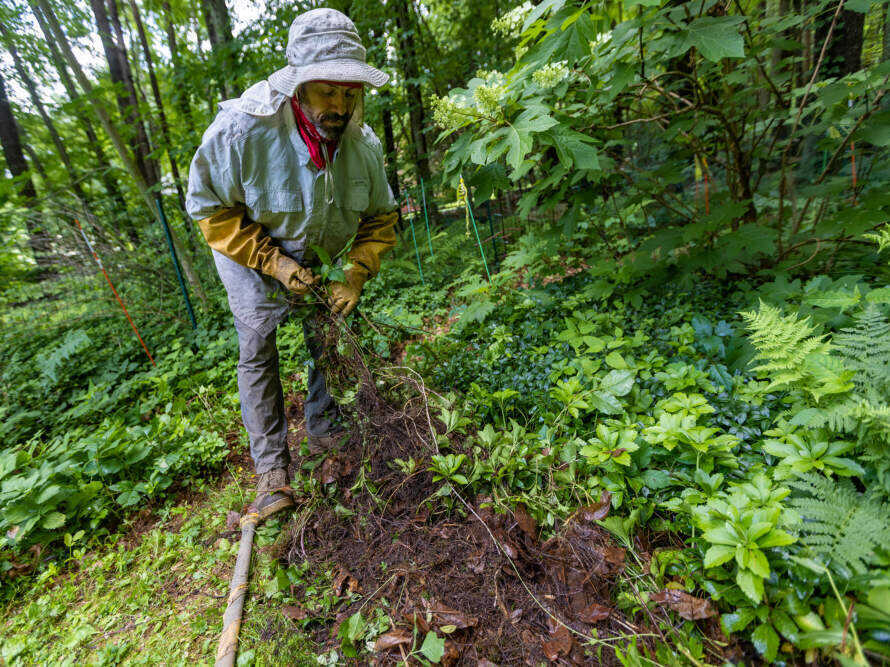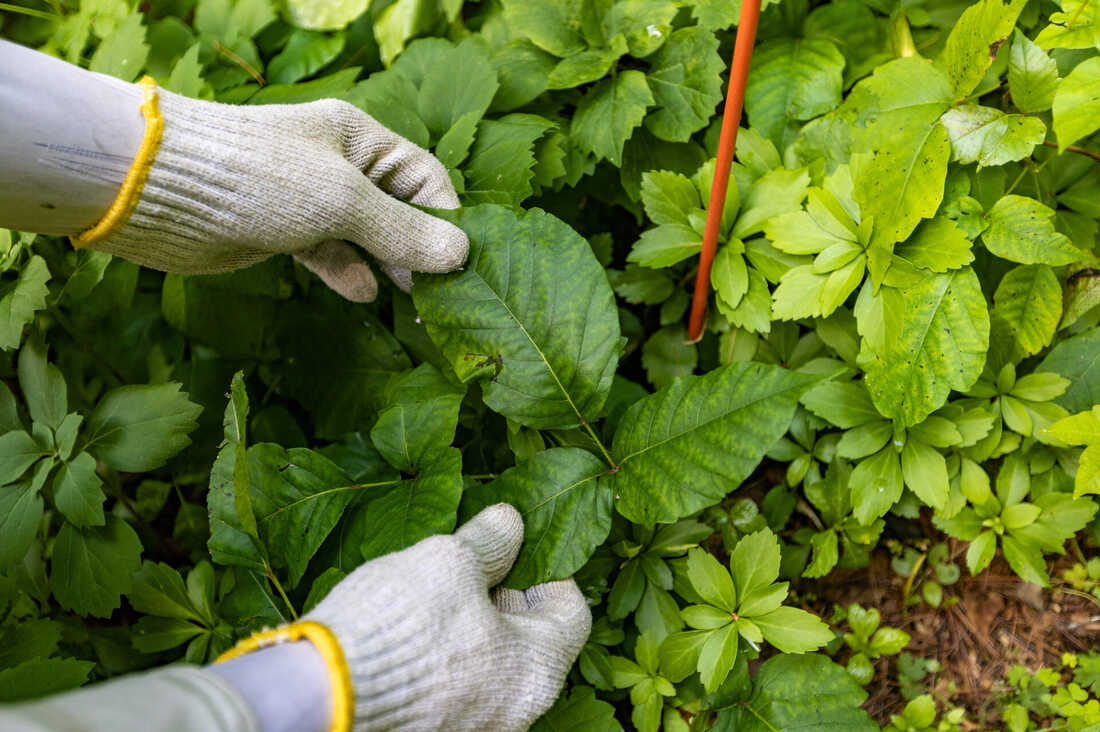Poison ivy is poised to be one of the big winners of a warming world

Peter Barron pulls out poison ivy vines in Harvard, Mass.
Jesse Costa/WBUR
hide caption
toggle caption
Jesse Costa/WBUR

Peter Barron pulls out poison ivy vines in Harvard, Mass.
Jesse Costa/WBUR
Over a decade ago, when Peter Barron started removing poison ivy for a living, he decided to document his work.
“Every year I always take pictures of the poison ivy as it’s blooming,” said Barron, who is better known as Pesky Pete, of Pesky Pete’s Poison Ivy Removal.
He still remembers the photos he took of the very first tiny, red, shiny poison ivy leaves popping out in Massachusetts and southern New Hampshire where he works.
“When I first started, it was May 10 or May 11,” he remembered. “I was so excited. I was like, ‘Wow, the season is here.’ “
Now, if he lines up all his photos from 14 years, the first sighting comes almost a month earlier. In 2023, his first glimpse was on April 18.
Barron may have unwittingly documented an effect of climate change.
Poison ivy is poised to be one of the big winners in this global, human-caused phenomenon. Scientists expect the dreaded three-leafed vine will take full advantage of warmer temperatures and rising levels of carbon dioxide in the atmosphere to grow faster and bigger — and become even more toxic.
Experts who have studied this plant for decades warn there are likely to be implications for human health. They say hikers, gardeners, landscapers and others may want to take extra precautions — and get better at identifying this plant — to avoid an itchy, blistering rash. (Learn how to identify it and test your knowledge with this quiz from WBUR.)

Barron thinks the earlier start to the season is because of shifting weather patterns.
“The weather has warmed up, and the plants are getting warm enough to open and bloom earlier and earlier every year in Massachusetts,” he said. “It’s very noticeable.”
Testing the theory
There is science to support Barron’s hunch.
In the late 1990s, a team of researchers designed an ambitious study to figure out how plants — and even a whole forest ecosystem — would respond to rising carbon dioxide levels in the atmosphere.

Pesky Pete Barron holds the leaves of poison ivy illustrating how it grows in clusters of three leaves.
Jesse Costa/WBUR
hide caption
toggle caption
Jesse Costa/WBUR

Pesky Pete Barron holds the leaves of poison ivy illustrating how it grows in clusters of three leaves.
Jesse Costa/WBUR
They built large towers around six huge, circular forest plots, to pump the gas into the air. The experiment was carefully computerized: If the wind was blowing from the west, the towers on the west would emit the gas, so it could float out over the rest of the forest plot and out the other side. The idea was to simulate what the scientists thought conditions would be like in 2050.
“A cylinder of the future is the way I like to call it,” explained William Schlesinger, now an emeritus professor at Duke University, who worked on the study along with scientists from the federal government.
Over a handful of years, the researchers watched the plants grow faster with more carbon dioxide. This was expected since plants essentially use the gas as food. The trees grew about 18% faster in the forest plots with a high concentration of carbon dioxide.
However, the vines grew even faster, and poison ivy was the speediest of all, growing 70% faster than it did without the extra carbon dioxide.
“It was the max. It topped the growth of everything else,” Schlesinger said.
And that’s not all: The researchers discovered that poison ivy became more toxic. The higher carbon dioxide levels spurred the plant to produce a more potent form of urushiol, the oily substance that causes the nasty skin rash we all try to avoid.

“But we don’t know why,” said Jacqueline Mohan, a professor at the University of Georgia’s Odum School of Ecology, who was involved in the study.
In another experiment, Mohan found the vine’s leaves grew larger with more carbon dioxide.
More recently, Mohan has been working on an ongoing study in the Harvard Forest in central Massachusetts, where researchers are artificially warming the top layer of soil by about 9 degrees Fahrenheit. The idea is to simulate the effect of climate change and measure how plants respond. Poison ivy appears to love the warmer conditions.
“My heavens to Betsy, it’s taking off,” she said. “Poison ivy takes off more than any tree species, more than any shrub species.”
Mohan said one reason for this growth is likely because, unlike shrubs and trees, vines can invest just about all their energy into length. They don’t need to build thick trunks or branches. Plus, she said, the artificially warmer soil seems to enhance a fungus that thrives in warm soil and helps poison ivy grow.
A bigger itch?
With climate change already starting to affect global weather and atmospheric conditions and carbon dioxide levels in the atmosphere rising, both Schlesinger and Mohan think it’s plausible that poison ivy is changing.
So far there aren’t observational studies on the topic. “It’s a nasty plant to work on,” Schlesinger noted. Mohan agreed: “It’s a remarkably understudied species.”
Some conservationists in Massachusetts report they’re seeing more of the vine growing around trails and yards. And doctors say they’ve seen more poison ivy rashes, including the kind that takes people to the emergency room.
“Every one of us sees it every week,” said Louis Kuchnir, a dermatologist with a practice of 10 doctors in the suburbs west of Boston. “And I mean the kind of cases where people can’t sleep and are covered with blisters.”
Roughly 80% of the population is allergic to poison ivy, but Kuchnir said only a small fraction of cases make it to a doctor. The severity of the reaction all depends on how an individual’s immune system responds to the oil in poison ivy.
“Some people will have a tremendous allergic reaction to poison ivy, and others just don’t seem to mount any allergic reaction at all,” he said.
Kuchnir suspects there may be another culprit to consider in the uptick in poison ivy reactions in recent years — the pandemic shutting down indoor activities and nudging people into their gardens and onto trails.
Just as more folks hit the trails, conservationists are noticing more poison ivy on paths and climbing up the trees. In Lincoln, Gwyn Loud has been keeping tabs on poison ivy’s expanding real estate.
“There is a lot more. [It’s] all over the place,” said Loud, who is on the board of the Lincoln Land Conservation Trust and has lived in the area for 55 years.
She’s noticed another change, too: The leaves are getting bigger.
Pointing to a patch of poison ivy growing on the forest’s edge, she noted leaves the size of a book. “I don’t think I’ve ever seen leaves as big as that,” she said.
Loud would like to see some hard data, but, if her observations are correct, it’s not good news for the vast majority of people who are allergic to poison ivy.
For all the latest Health News Click Here
For the latest news and updates, follow us on Google News.

